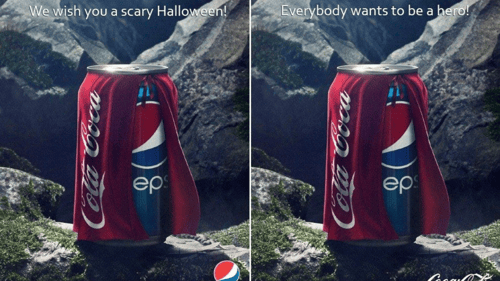The real purpose of email in the modern digital world

Posted by Greg McLoughlin
June 15th, 2016
Remember letter-writing? Possibly the last non-official letter I wrote was to my European pen-pal in school. I was eight. She never wrote back.
Tough times.
In many ways, writing letters (or direct mail to go with the marketing equivalent) is obsolete. It's an old communications method that's flown out the window in place of email or social media.
The way we as marketers communicate with our audience and drive our message through has really come a long, long way over the last half a century.
Traditional platforms such as billboards and print have been replaced by a more convenient experience for the user and a more quantifiable model for both the marketer and client with the inevitable rise of digital.
Old-school advertising has ultimately turned into social ads that inconspicuously show up on our timelines, online blanket sponsored editorial, PPC ads on the top of your SERPs like a sore thumb and, last but not least, on-site content that engages with your audience and builds credibility for your brand.
Marketers have always had to keep up with the ever-changing platforms to keep the digital romance between their audiences going, but one digital platform has somehow managed to outlive them all. It was there at the birth of the digital era and it's not going away anytime soon.
The almighty email! Since the invention of the first email system in 1977 by Ray Tomlinson (fun fact: the text of the first ever email sent was apparently QWERTYUIOP - the first ten letters on the keyboard), the email remains an integral part to both our work and personal lives as well as our marketing strategy. All hail!

While "give them a text" has been changed to "give them a Whatsapp" or "Facebook Message them", email is still much the same as it was in its inception.
But what's its real purpose today?
Email will always have a vital function in our work lives, but does it still have the same impact for a business? Does the usual weekly newsletter or update on new products really serve a purpose to an audience in order to convert?
That's a hard question to answer. Yes, newsletters and product/news updates still do serve some kind of benefit, but eventually, your mind learns to filter the bullshit.
Out of all of the emails that squeeze their way into your inbox, how many of them do you open? And more importantly, how many of them do you click through?
Seasonal sales and our content aside ( ;) ), I can't imagine that it's too much. So how do you use emails that really serves your audience and how are other brands doing it well these days?
One word - personalisation. This is the key to getting your audience engaging with your emails.
Have a look at the email below from hipster giants Urban Outfitters.
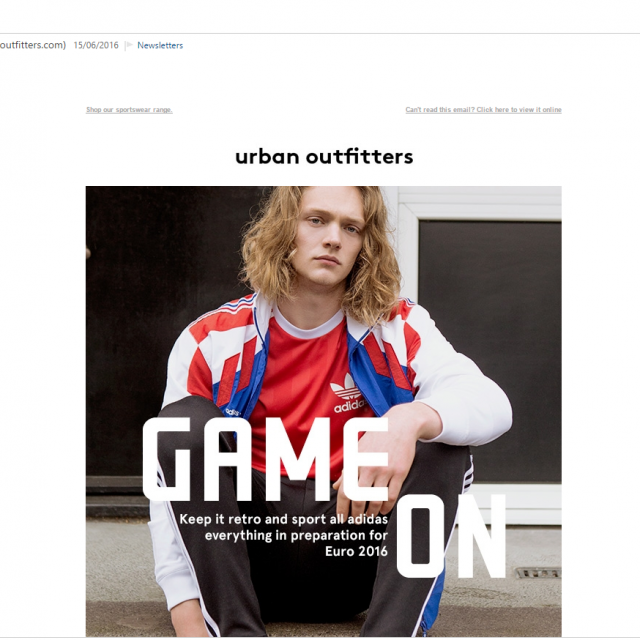
Can you tell me what's wrong with it?...
There's nothing personal about this email to me. I like Adidas as much as the next guy, but Urban Outfitters don't know that - or at the least I haven't told them that. (Pro-tip: segment e-commerce shoppers by brand buys, if you want to go down this avenue.)
And sure, this will definitely get some click-throughs, but sweeping all of their subscribers with an impersonal email like this won't get the maximum CTR possible.
Now, take a look at recent email from eCommerce giants Amazon.
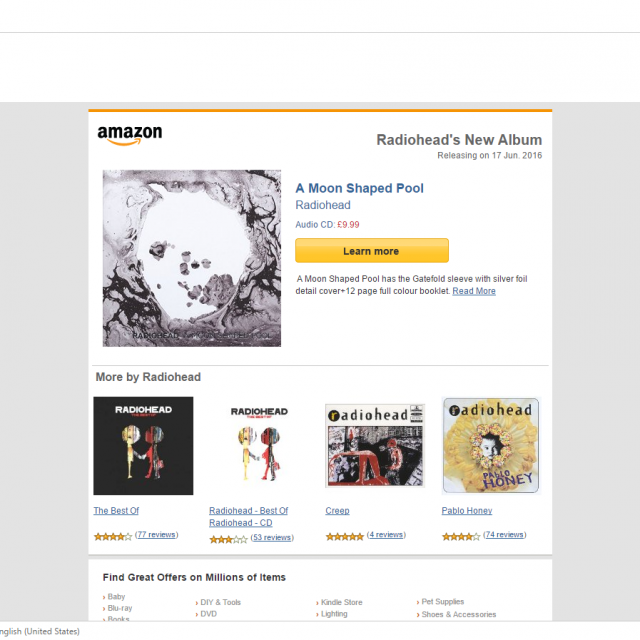
Now why is this email so effective?
Because I like Radiohead and Amazon knows that. I've purchased some Radiohead records off Amazon in the past and now they're sending me content and products they think is relevant to me. (Also, how good is their new album 'A Moon Shaped Pool'? Wow.)
Even if I don't make a purchase and just scroll on their website, Amazon still manages to send me products that I'm potentially interested in.
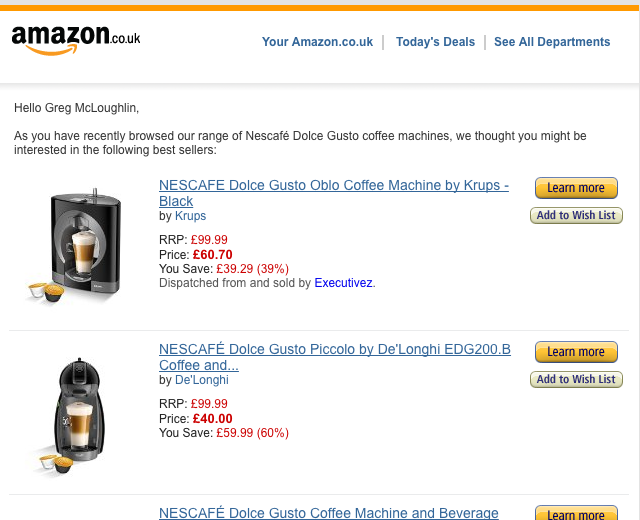
Think about it, if the content in your emails is relevant to the subscriber, there's surely a far better chance that they're going to click-through, right?
That's the key to really using email marketing in the best way. A study from Marketing Land showed that personalised emails deliver 6X higher transaction rates, but 70% of brands fail to use them.
Say what?
Always remember the more relevant the content in your email is to the user, the better your emails will perform. That's what it's going to take to make sure that your emails are a functioning member of your strategic ecosystem.
Email marketing and inbound
There's also another way you can effectively use email to qualify your leads and increase conversions for your business.
And that, my friend, is lead nurturing. This is essential to any inbound strategy.
Using content to nurture your audience down the funnel and influencing them to make a purchase decision is a game-changing way to increase credibility and conversions.
It's all about helping your audience with content that's relevant to any issues they're experiencing and from the info you collect from your content assets. That's the heart of any textbook inbound strategy.
Create brilliant content assets and a landing page with an offer form so you can collect the information you need to start the nurturing process.
Find out where they are in the buyer's journey, any problems they're experiencing, if they prefer Pepsi or Coke or whatever else you need so you can define where they are in the process and bring them through each stage of the journey and prepare them to convert. Don't forget to define your buyer personas so you can give them the most relevant content possible! Once you tick all of those boxes, you're all gravy, baby.
Remember, your content assets need to be 'amazeballs' so your audience will actually go to the effort of giving that information to you (that's where we come in ;) ).
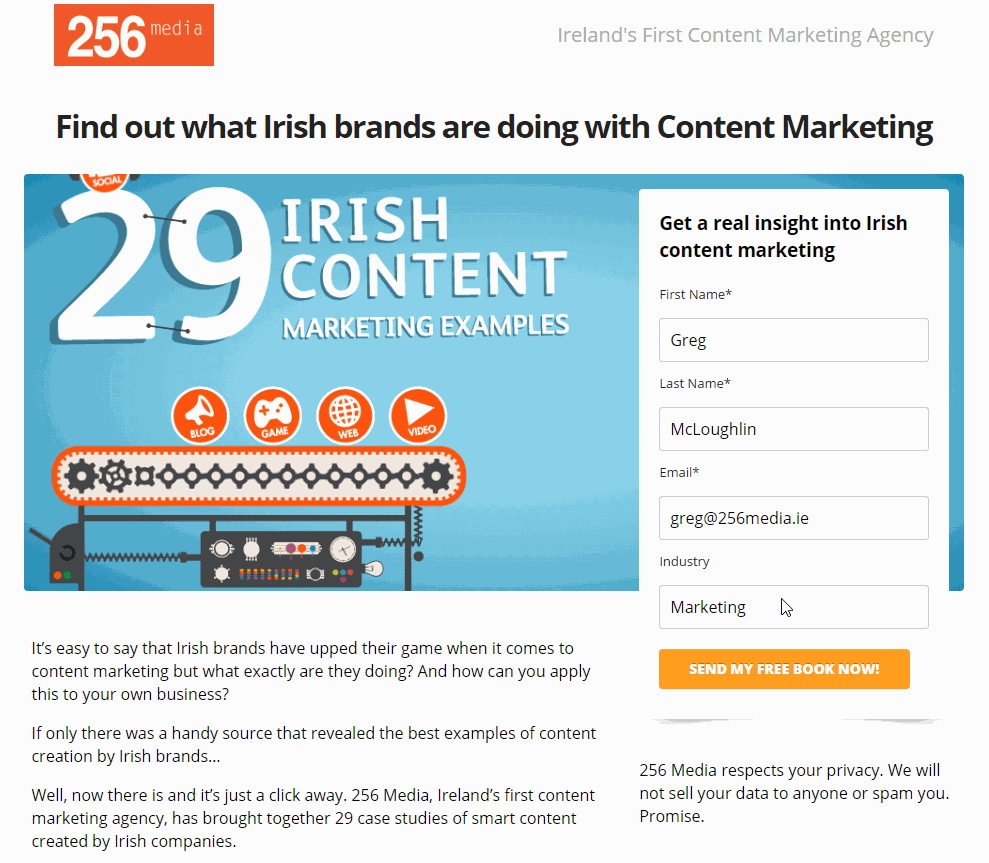
HubSpot offer a full CMS service where you can create landing pages, create and publish content, store information on your leads that you acquire through your landing page forms and create automated workflows under the terms you lay out to nurture your leads down the funnel.
Mailchimp and other mail services offer workflow automation, but with HubSpot's CMS, each and every single step can be monitored and you can see exactly how your audience is engaging with your content and your website, along with every other reporting bell and whistle you'd ever need to create the ultimate inbound strategy - all under one beautiful roof.
One final step on the personalisation train is this: make your emails more personal!
Like I said, people have started to see through the bullshit, so you need to think of different ways to get your message across and gain the precious click-through.
Using text emails as opposed to HTML can help you opt for a more one-on-one experience for the user. In a 2014 survey from HubSpot, over a thousand professionals were asked whether they preferred HTML-based or text-based emails and whether they preferred emails that consisted of mostly text or mostly images.
Nearly two-thirds of the respondents said they preferred HTML and image-based emails, but in every single A/B test, the simpler design won every time. Plain-text emails got both significantly more opens and clicks than its HTML counterpart.
To put this to the test, we actually opted for plain-text emails for two months to see if it made a difference to our own communication. Our former emails with images and prominent CTAs got a face-lift for a more personal experience.
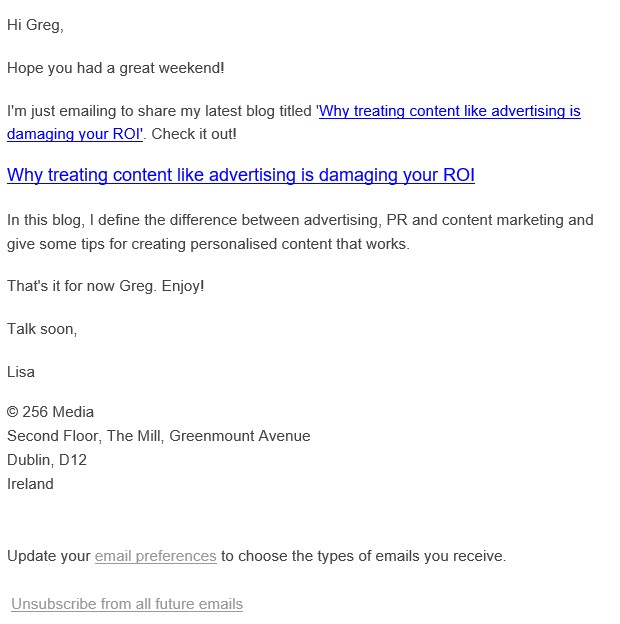
And what happened? We actually did get more opens and clicks. In fact, our emails are performing over 5 times better than the 2016 agency benchmark. You can't really argue with that! Thanks, HubSpot. :)
So what can we learn from this?
It's all about breaking the mould and giving your audience something that they don't get every day from everybody else. Personalising your content will strike a chord and efficiently engage with your audience on a whole new level.
If you're churning out the same old mails each week, consider rethinking your strategy and optimising your content to give your audience a more one-on-one experience to get your emails working for you. Otherwise, it's a wasted opportunity.
Need help engaging with your audience the right way?
Are you looking to strike a chord with your audience and nurture them down the funnel through the powers of content marketing? Why not get in touch and talk to our award-winning team? We’re creative content specialists with digital in our DNA so we’ll be happy to help.
In the meantime, follow us on Facebook, Twitter, and Instagram to keep up to date with all the latest news on content marketing and all things digital.

Greg McLoughlin

Previous Post
Why treating content like advertising is damaging your ROI
Next Post

Get your SEO together with Varvy
Subscribe Here
You may also like...
Nicole Thomsen | Dec 11, 2023
Nicole Thomsen | Nov 6, 2023
Nadia Reckmann | Nov 2, 2023





